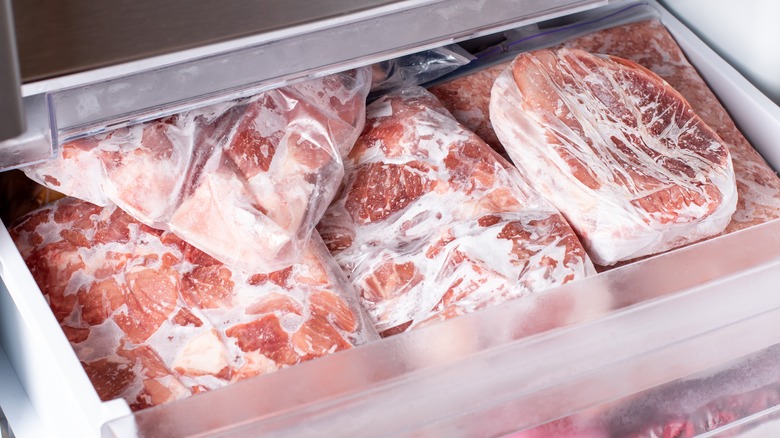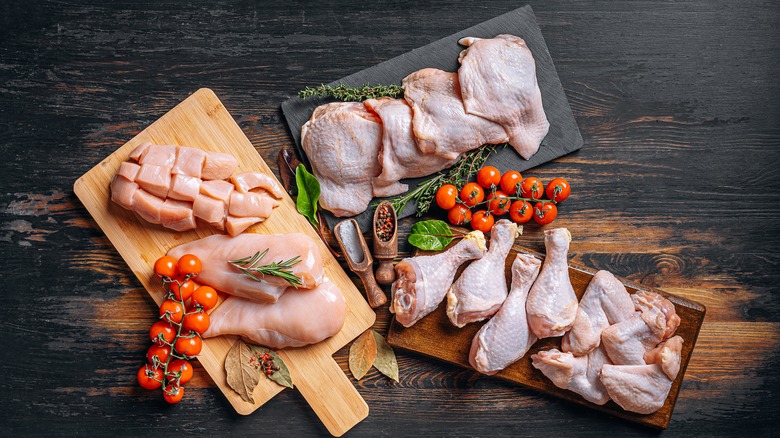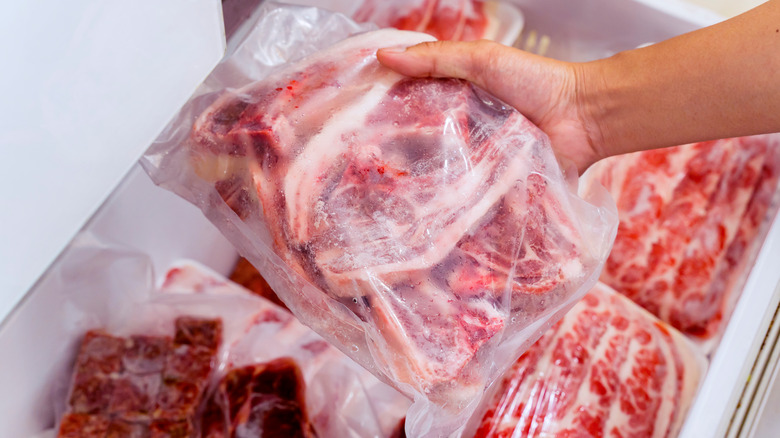The Time-Saving Tip For Making Freezing Raw Meat Even Easier
It's the morning of a very stressful day, and you're anxious to get out the door. Luckily, you haven't forgotten you need to thaw a piece of chicken for tonight's dinner recipe. You take the package out of the freezer, cut it open, and go to grab a piece, only to discover the chicken has completely frozen together and can't be separated. Whatever — you put the whole package in the fridge and resign yourself to eating leftovers for a few days.
Later, tired and hungry, you arrive home to discover the chicken hasn't thawed. The cuts that had frozen together were too thick to thoroughly defrost in the allotted time, and your choices are to order in or to resign yourself to the extra cooking time and the dry, overcooked outer sections of meat.
Many home cooks know this story all too well. However, there's an easy way this saga can be avoided using a bit of forethought and a few freezer bags or pieces of plastic wrap. To save time and headache while thawing meat, freeze the meat into individualized portions.
How to freeze meat in portions
When you bring home meat you intend to freeze, separate the pieces immediately rather than sticking the package in the freezer. If you don't have time right away, keep the meat under refrigeration — where it will stay fresh for a couple of days — until you're ready to begin. Grab a roll of plastic wrap or enough freezer bags for the number of meals you plan to make from the given package. If you're cooking for one, this likely means dividing the meat into solo cuts or single-serving portions. For more eaters, do the math on how much you'll be cooking at once.
Cut open the package of meat and divide it into portions, placing each one in a freezer bag or wrapping it in plastic wrap. To prevent freezer burn, try double-wrapping the meat, such as by wrapping first in plastic wrap and then wrapping in aluminum foil, or by placing individually-wrapped pieces in a freezer bag. Squeeze as much air out as possible to minimize air contact with the meat.
Place the portions in the freezer, spreading them out to ensure cold air can circulate between them. Once completely frozen, these parcels can then can be consolidated in one place. When it's time to thaw, put a portion in your refrigerator, either in its existing wrapping or to air dry.
Benefits of this meat-freezing technique
The main benefit of this technique is that it will allow the meat to thaw more quickly. Rather than placing a big block of frozen food in the fridge and hoping for the best, you can transfer over one or two portions, which are smaller and can thaw much more efficiently. It also allows you to only thaw as much as you need, which prevents you from having to make or eat more food than you were intending in a short period of time. This also helps cut down on food waste, which is better for the planet and for your wallet.
In addition, freezing meat in portions allows the meat to freeze faster than it would in a big chunk, which preserves the quality of the meat. According to the USDA, freezing food too slowly results in large ice crystals, which can damage the texture of the meat when it thaws. Flash-freezing food prevents large crystals from developing, better preserving the caliber of the meat. Portioning increases the cooling rate because the pieces are smaller and can be better penetrated by the cold air.
Next time you have meat to freeze, there's a handy defrosting hack using an aluminum baking sheet that you should keep in mind before storing. You'll save time and energy when thawing individual portions, and you can save money buying bulk packages that you won't need to use all at once. This makes thawing and cooking meat a breeze.


